Chemical splash goggles are essential for soap makers working with lye and other caustic ingredients. Unlike safety glasses, these goggles create a complete seal around your eyes, preventing dangerous splashes from causing potentially permanent damage. Don't substitute with onion goggles or regular eyewear—they won't protect you from chemicals. For maximum safety, pair your goggles with a face shield during high-risk steps. Proper eye protection isn't optional—it's the difference between a safe hobby and a devastating accident.
Understanding Eye Safety Risks in Soap Making
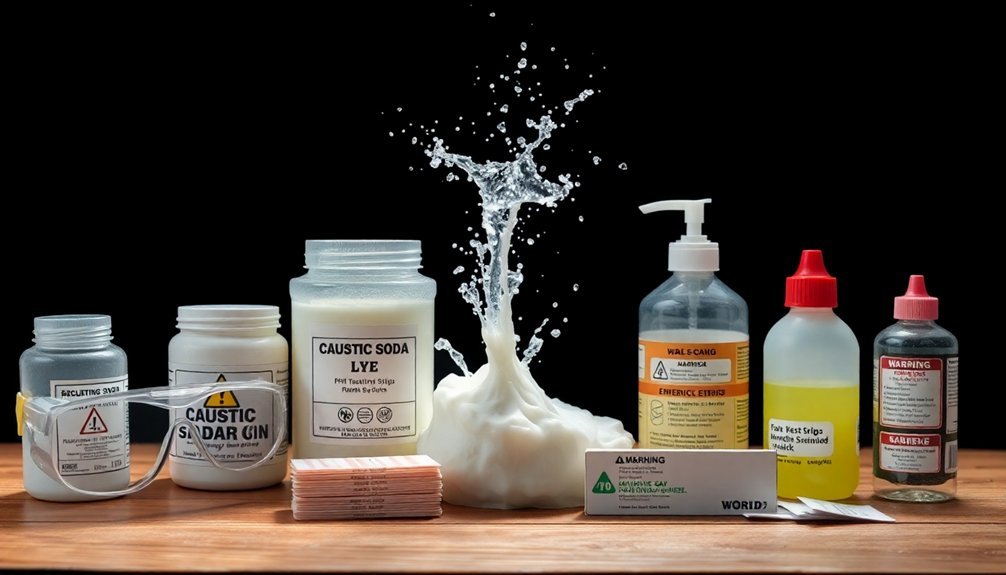
While many crafters focus on perfecting their soap recipes, the dangers lurking in the ingredients pose serious threats to your eyes. Lye and raw soap can cause devastating injuries if they splash into your unprotected eyes, potentially leading to permanent damage or blindness.
You're handling caustic chemicals that don't forgive mistakes. Even experienced soap makers can have accidents—a slight bump of your workspace or an unexpected reaction can send dangerous droplets flying.
That's why proper eye protection isn't optional but essential.
Chemical splash goggles, especially those with indirect venting, provide the thorough protection you need. Unlike basic safety glasses, these goggles create a sealed barrier that prevents hazardous liquids from reaching your eyes while still allowing airflow to prevent fogging.
Different Types of Eye Protection for Soap Makers
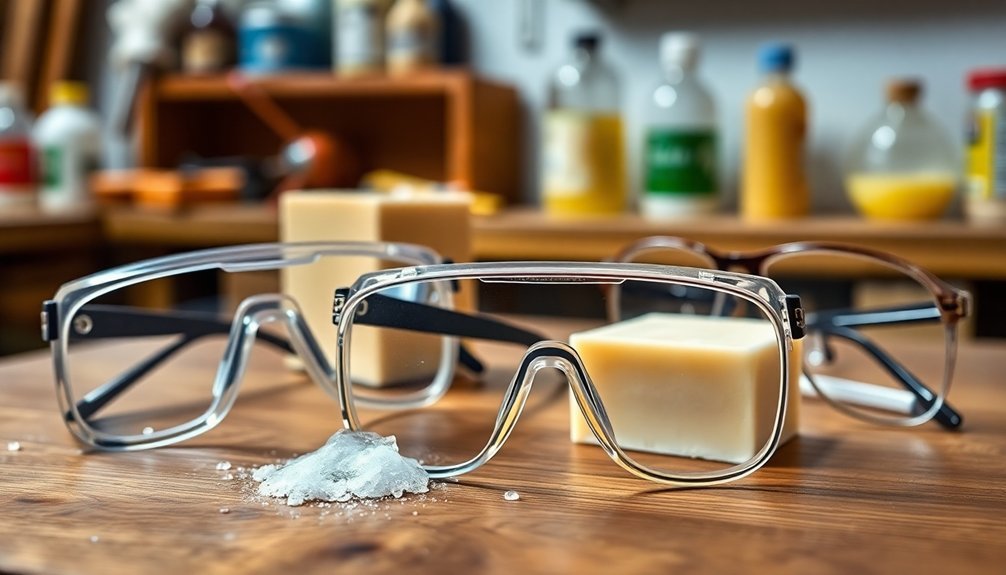
Because your vision is irreplaceable, choosing the right eye protection for soap making isn't just a safety precaution—it's a necessity.
Chemical splash goggles are your best option, offering superior protection against caustic liquids and irritating dusts. Look for ANSI Z87.1-2010 or CSA Z94.3 certification to guarantee they meet safety standards.
Don't rely on standard safety glasses—while they protect against impact, they're inadequate for the chemical splashes you'll encounter when working with lye.
Face shields can provide additional protection when used with goggles but shouldn't be your only defense.
And despite their name, onion goggles aren't designed for chemical protection.
Always wear proper eye protection throughout the entire soap making process, especially when handling lye, to prevent serious injury.
Chemical Splash Goggles vs. Safety Glasses: Key Differences
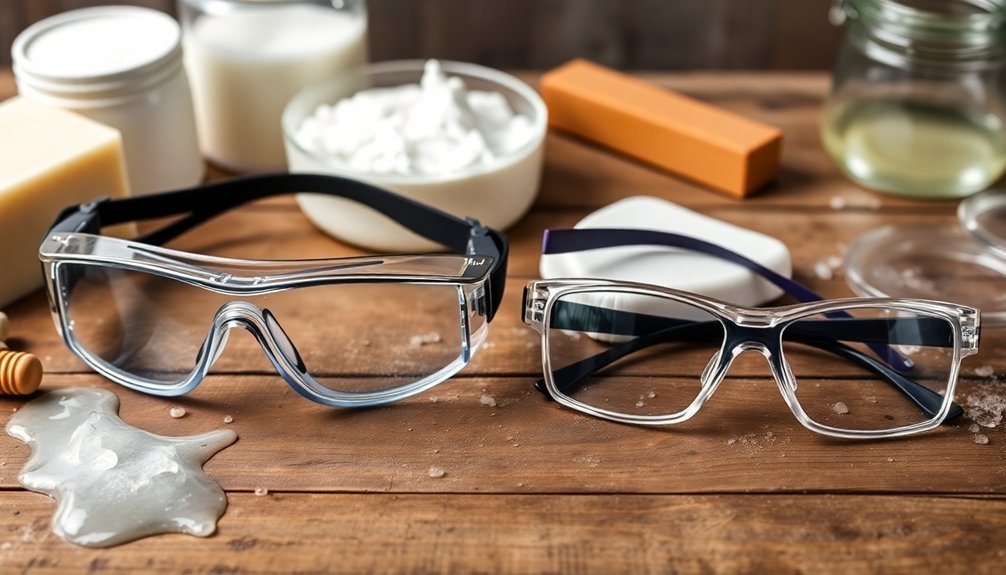
When comparing eye protection options, you'll find chemical splash goggles offer wraparound coverage with special venting that prevents caustic lye solution from reaching your eyes, while safety glasses mainly protect against front and side impacts.
Certified chemical goggles meet ANSI Z87.1-2010 or CSA Z94.3 standards specifically for chemical exposure hazards, providing superior protection compared to standard safety glasses which aren't typically rated for soap making's chemical risks.
You'll notice chemical goggles are designed to fit comfortably over prescription glasses and include anti-fog features, whereas safety glasses might press uncomfortably against your temples during longer soap making sessions.
Protection Coverage Comparison
Although both options offer eye protection, chemical splash goggles and safety glasses differ markedly in their protective capabilities for soap makers.
When working with caustic lye and essential oils, the protective coverage becomes critical for your safety.
Chemical splash goggles provide superior protection in three essential ways:
- They form a complete seal around your eyes, preventing splashes from entering from any angle, while safety glasses leave gaps where chemicals can enter.
- Their indirect vent design specifically stops hazardous liquids from reaching your eyes, a feature absent in standard safety glasses.
- Chemical splash goggles accommodate prescription glasses underneath, ensuring those who need corrective lenses don't compromise on protection.
Impact Resistance Standards
Beyond protective coverage, impact resistance serves as an important safeguard for soap makers facing multiple hazards.
When selecting eye protection, you'll need to verify certification to recognized standards—specifically ANSI Z87.1-2010 in the USA or CSA Z94.3 in Canada.
While both safety glasses and chemical splash goggles can meet these impact resistance standards, their practical applications differ greatly.
Safety glasses provide basic protection against direct impacts but fall short when confronting chemical splashes common in soap making.
Chemical splash goggles offer superior protection with their specialized design features.
For soap makers, the distinction is vital—chemical splash goggles not only meet impact resistance standards but also provide the thorough protection needed when working with caustic ingredients.
Don't compromise on certification when your eye safety is at stake.
Fit and Comfort Considerations
Three essential factors distinguish chemical splash goggles from standard safety glasses when considering fit and comfort for soap making.
Chemical splash goggles provide superior protection with their secure foam seal around the eye socket, while safety glasses offer minimal coverage against splashes.
When selecting eye protection for soap making, consider:
- Proper fit – Goggles create a complete seal around your eyes, preventing dangerous lye or essential oils from entering, unlike safety glasses' open sides.
- Comfort with prescription eyewear – Quality goggles accommodate your regular glasses without pressure or discomfort.
- Fog prevention – Chemical splash goggles with anti-fog coatings and ventilation systems guarantee clear visibility during the entire soap-making process.
Don't compromise on comfort—properly fitted goggles provide both protection and extended wearability.
Face Shields and Combined Protection Options
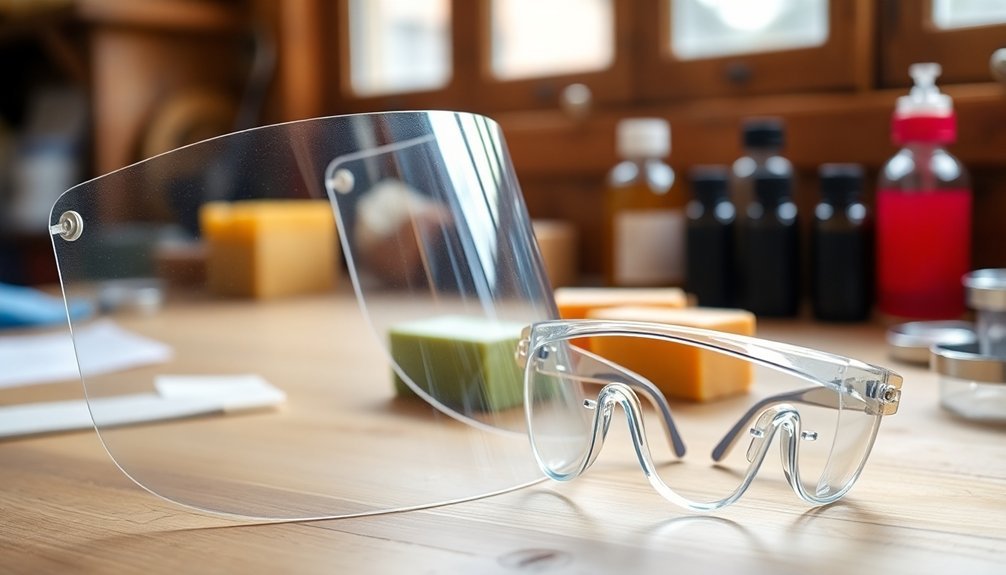
Several high-quality face shields offer soap makers extensive protection against chemical splashes while maintaining clear visibility during the crafting process.
When selecting face shields as your protective gear, look for ANSI Z87.1-2010 or CSA Z94.3 certification to confirm they meet safety standards.
While face shields excel at protecting against splashes and sprays, they don't provide adequate protection against hazardous dusts.
For thorough eye protection, consider combining face shields with goggles. Models with indirect vent designs help reduce fogging, improving comfort during your soap making sessions.
If you're using an industrial respirator, you'll need to verify compatibility, as many face shields won't fit properly over respirators.
In these cases, seek specialized combined protection options that accommodate both needs without compromising your safety.
Proper Fit and Maintenance of Eye Protection Gear
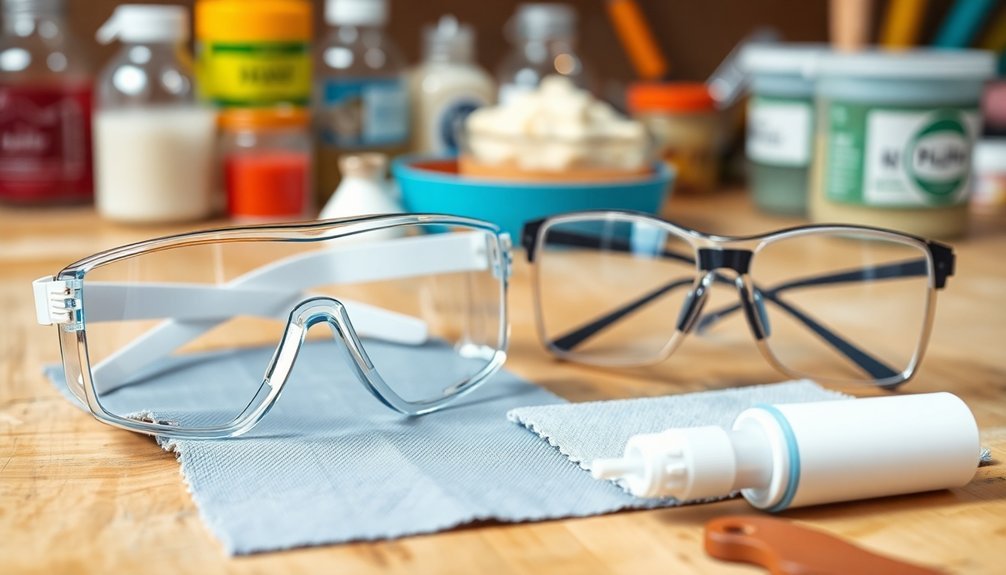
The effectiveness of your eye protection gear depends entirely on its proper fit and regular maintenance.
Safety goggles should create a tight seal around your eyes, while face shields must securely attach to your head without shifting during soap making activities. If you wear prescription glasses, select goggles designed to fit over them without compromising the protective seal.
Maintain your eye protection by:
- Inspecting gear regularly for signs of wear, damage, or fogging
- Cleaning lenses with mild soap and water to maintain visibility
- Replacing equipment that no longer meets ANSI Z87.1-2010 or CSA Z94.3 standards
Proper fit guarantees dangerous lye splashes can't reach your eyes, while consistent maintenance extends the life of your gear and optimizes your visibility when working with caustic ingredients.
Real-Life Soap Making Accidents and Prevention Strategies
While proper fit and maintenance of safety gear protect you in theory, examining actual soap making accidents reveals why vigilance can never waver.
Numerous soap makers have suffered serious eye injuries from lye splashes, resulting in emergency hospital visits and potential long-term damage.
Even experienced crafters aren't immune—many report near-misses that could have been catastrophic without proper goggles.
Remember, lye accidents happen unpredictably during all stages of the soap making process.
Your prevention strategy should include:
- Wearing chemical splash goggles during every session
- Ensuring immediate access to running water or an eyewash station
- Maintaining eye protection during lye preparation and pouring
Don't let complacency compromise your safety—regardless of your experience level, proper eye protection remains your first defense against life-altering accidents.
Frequently Asked Questions
What PPE Is Needed for Soap Making?
You'll need chemical splash goggles (ANSI Z87.1-2010/CSA Z94.3 approved), nitrile gloves, a full-length chemical apron, closed-toe shoes, and an appropriate respirator when making soap to protect against lye and irritating dusts.
What Should You Wear to Protect Your Eyes Against Splashing Chemicals?
You should wear chemical splash goggles that are ANSI Z87.1-2010 or CSA Z94.3 certified. They'll protect against hazardous liquids better than safety glasses. Choose ones with indirect vents and anti-fog coating for ideal protection.
What Eye Protection Should Be Worn When Operating Machinery?
When operating machinery, you'll need ANSI Z87.1-2010 or CSA Z94.3 certified safety goggles. For grinding or cutting, add a full face shield over your goggles. Make certain they fit snugly and inspect them regularly.
What Type of Eye Protection Is Best When Working With Chemicals?
When working with chemicals, you'll need chemical splash goggles certified to ANSI Z87.1-2010 or CSA Z94.3. They're superior to safety glasses and should have indirect vents and anti-fog coating for maximum protection and visibility.
In Summary
Don't compromise on eye protection when making soap. You'll need chemical splash goggles that form a complete seal against lye splashes. For maximum protection, pair them with a face shield when handling caustic materials. Remember to inspect your gear regularly for damage and replace as needed. The few seconds it takes to put on proper eye protection can save your sight for a lifetime.

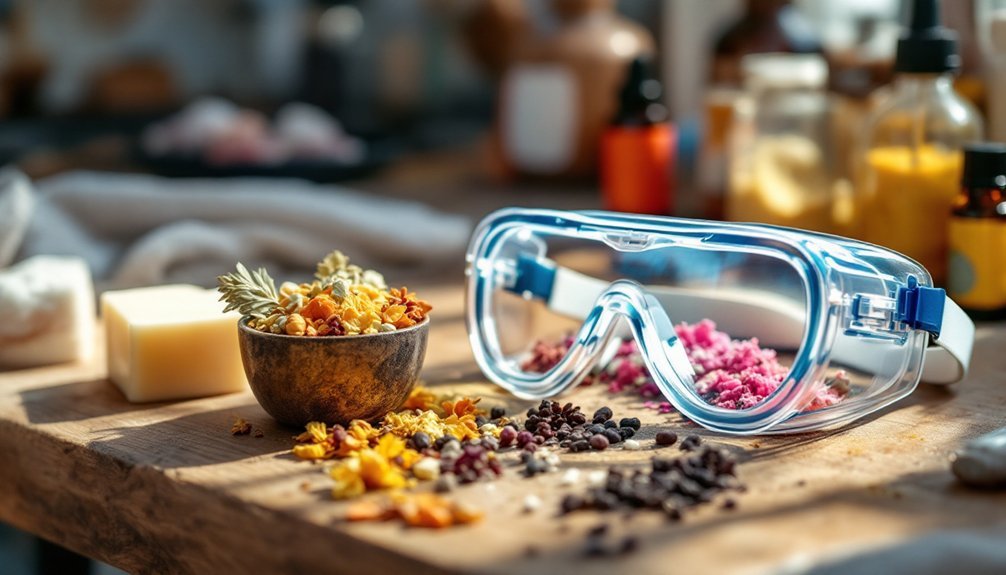



Leave a Reply